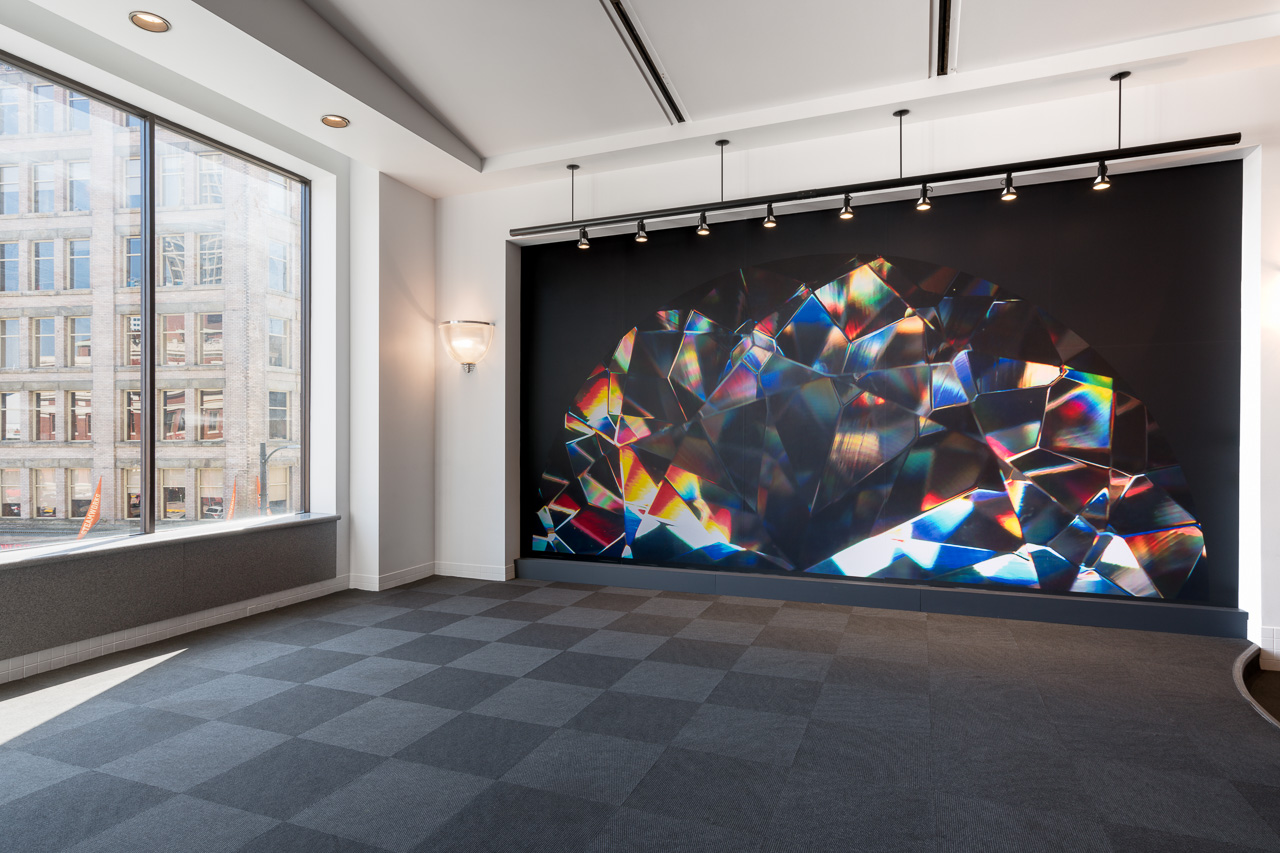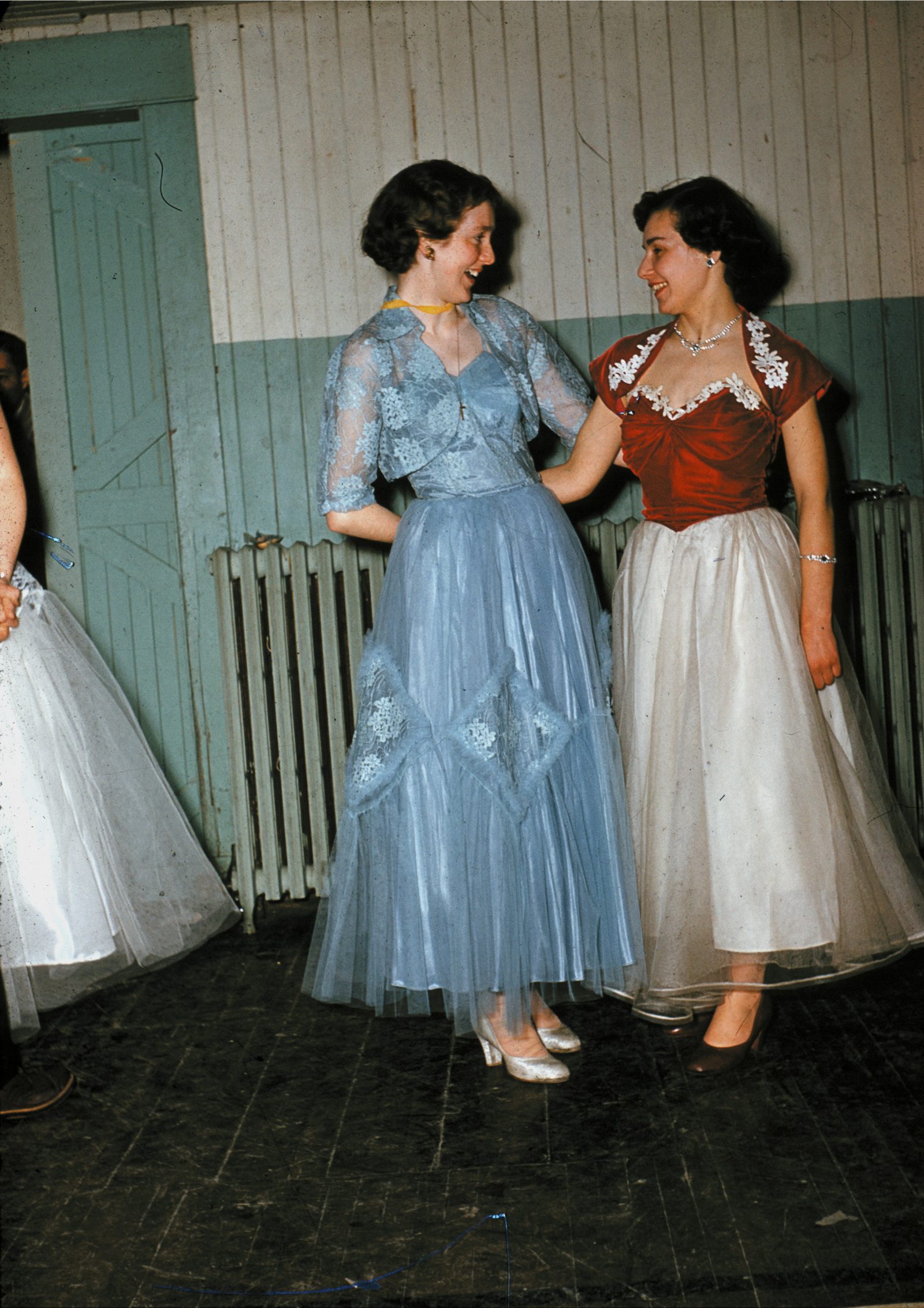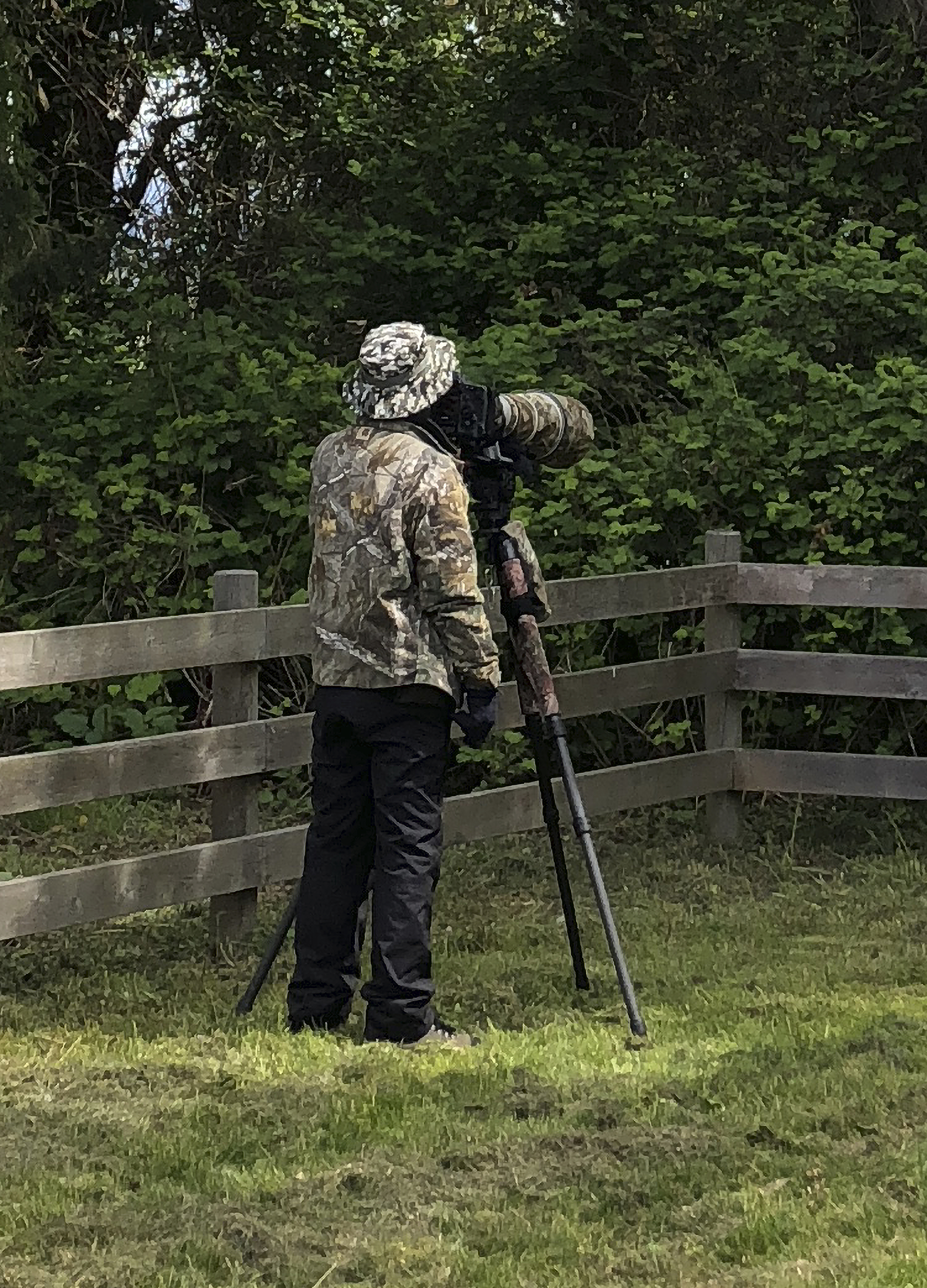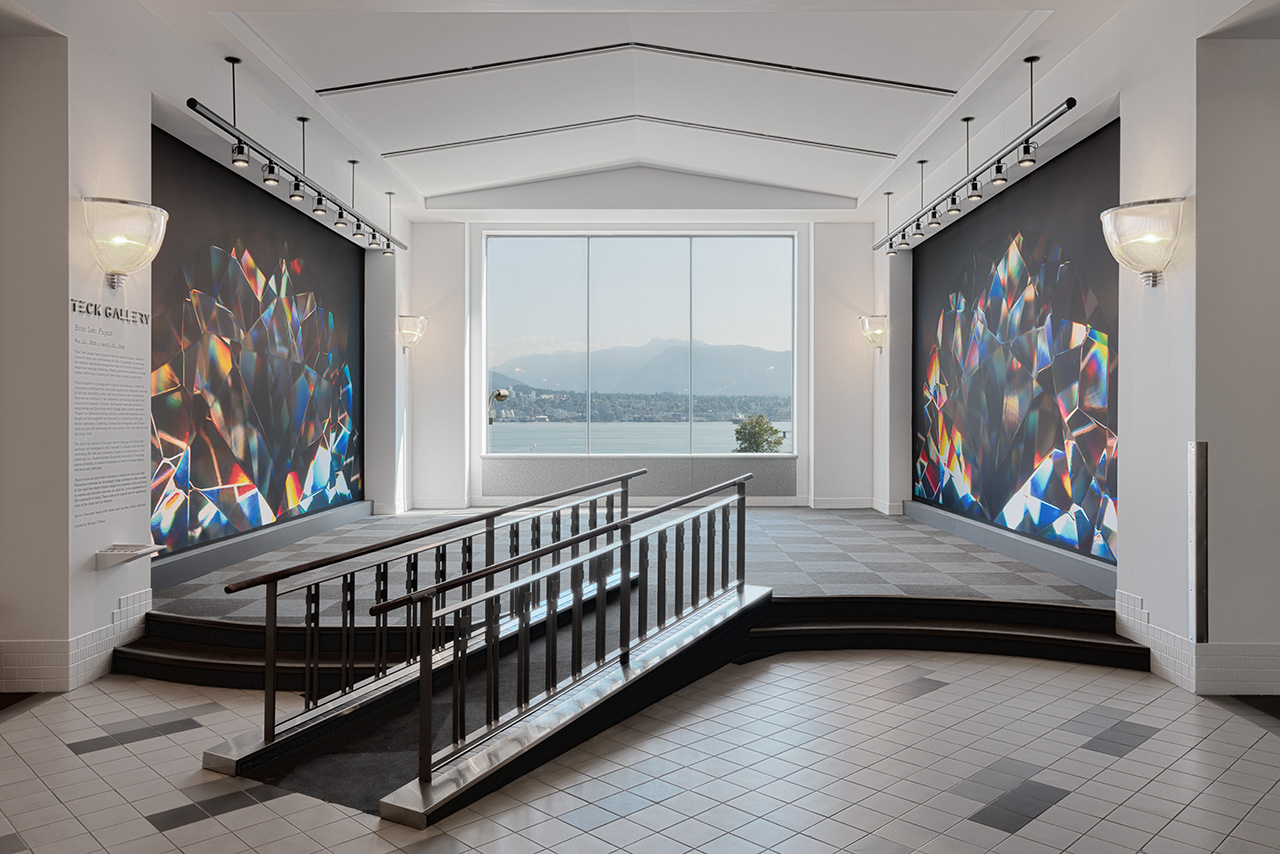Evan Lee: Fugazi was on view from May 11, 2019 – April 26, 2020 at SFU Galleries’ Teck Gallery in Vancouver.
I want to take seriously the argument that fakery, the fugazi[1] nature of Evan Lee’s artwork can be read through a Marxist critique of finance capitalism. That is, a critique of fugazi can help us to understand why Marxism must not overlook the importance of immaterial, emotional, and other forms of non-capital producing labour. The problem with calling something fugazi, whether it is the smoke and mirrors of stock brokers or a zirconium stone, is that it presumes an unassailable veracity or ontology of, say, real labour, or real diamonds.
From Jameson to Scorsese to Fugazi
Fredric Jameson is arguably the most significant Marxist critic in the English-speaking world, author of key texts that introduced Marxist Theory and the Frankfurt School to American academics in the 1970s and 1980s[2]. The Wolf of Wall Street is Martin Scorsese’s 2014 film based on a 2007 memoir by Jordan Belfort, who made his start selling penny stocks in the 1980s and went on to accumulate millions through shady insider trading and other fraudulent practices before going to jail, writing the memoir, and having an afterlife as a motivational speaker.
The Wolf of Wall Street is certainly a finance film, akin to The Big Short (Adam McKay, 2015) or Margin Call (J.C. Chandor, 2011), but it is also a gangster or crime film like Dog Day Afternoon (Sidney Lumet, 1975), The Godfather (Francis Ford Coppolla, 1972), or Scorsese’s Goodfellas. In a famous essay on mass culture and reification, Jameson makes the following argument regarding The Godfather:
“When we reflect on an organized conspiracy against the public, one which reaches into every corner of our daily lives and our political structures to exercise a wanton ecocidal and genocidal violence at the behest of distant decision-makers and in the name of an abstract conception of profit— surely it is not about the Mafia, but rather about American business itself that we are thinking, American capitalism in its most systematized and computerized, dehumanized, ‘multinational’ and corporate form. What kind of crime, said Brecht, is the robbing of a bank, compared to the founding of a bank?” [3]
If The Godfather was a mob film that was really about corporate capitalism, perhaps The Wolf of Wall Street is a Scorsese gangster film in the guise of an indictment of finance capital. In an early scene in the film, Belfort has his first job on Wall Street, working for a prestigious, blue chip firm, L.F. Rothschild. He is taken for the ubiquitous three martini lunch by senior broker Mark Hanna, played by Matthew McConaughey, who proceeds to school Belfort in what we call immaterial labor. Hanna advises Belfort that selling stocks is all about fugazi, and that therefore one should masturbate, drink, and do drugs as much as possible.
It is important to realize how this thesis is expressed cinematically. Take the film’s use of fugazi. Hanna, before he tells Belfort that “we don’t create shit, we don’t build anything,” says, “It’s all a fugazi, you know what a fugazi is?” Here Hanna pronounces it with a short a. To which Belfort answers “No, fugazi, it’s a fake.” Belfort pronounces it with a long a. And Hanna comes back pronouncing the word both ways: “Fugazi, fugazi, it’s a wahzi it’s a woozy, it’s fairy dust, it doesn’t exist, it’s never landed, it’s not matter, it’s not on the elemental chart, it’s not fucking real.” Hanna’s pronunciation is that of the Washington, D.C. hardcore band Fugazi (which apparently comes from a Vietnam War slang term for “Fucked-up, got ambushed, zipped into a body bag”). And Belfort’s is the pronunciation used in Donnie Brasco, when Donnie (Johnny Depp) tells Lefty (Al Pacino), that the diamond ring he’s trying to sell is fugazy, or a fake (an NYC mob slang term, derived from commercials for the Fugazy limousine service in the 1970s). In spelling and pronunciation, the fakery inherent in the stock market, turns out to be deeply dialectical.
Belfort’s “crew” of salesmen, many of whom are petty criminals, are not only a kind of heist picture motif, but also an allegory (a privileged technique for Jameson) for the collective, for the possibilities of class revolt. But Jameson is also a key theorist of postmodernism, and so helps us to understand that the film’s turn to other media—its incessant use of real and made-up (fugazi?) commercials, for instance—is a way of situating the modernist medium of film in a post-cinematic landscape. A media ecology where “immaterial” labour and objects, the existential threat of downloading, and misleading film trailers are the new normal. Jameson argues that classic seventies films like Jaws, The Godfather, Dog Day Afternoon, and All the President’s Men are attempts, respectively, to negotiate American postwar history, or to critique capitalism via the mob, or to think about class in our mediatized present, or even to think about global capitalism as a totality via representations of conspiracy.
A Jamesonian interpretation will find a social meaning in how a film works formally, and The Wolf of Wall Street’s volatilization of media ecology forbids us from falling into what I call a “labourist-substantialist” critique of finance capital—the argument that whereas factory workers and other blue-collar types actually make things, stock brokers merely “push paper” around: it’s all “fugazi,” or fake.[4] For this last ideology—call it Fordist nostalgia—can evidently be used to disparage many other kinds of labour besides finance capital— from the gendered “pink collar” ghetto of the information and service economies to today’s digital, precarious, and affective forms of work. That is, through its very investment in the “libidinality of the fugazi” (and using investment here in both economic and psychic senses), The Wolf of Wall Street helps us to understand better both the crisis and how to organize.[5]
My argument with respect to The Wolf of Wall Street is that fugazi qua “ideologeme” (more on this concept below) is symptomatic of a contradiction at the heart of capitalism. That is, the belief, even among capitalism’s critics, that the production of goods serves a higher purpose – whether moral or ontological – than finance capitalism. Such a mindset is the same mindset that devalues the service sector, women’s labor, affective or emotional labour, intellectual or immaterial labor. The problem is, then, that this is a workerist ideology (real labor is making things – often coded as masculine labor), whereas theories of immaterial labor (Silvia Federici, Hardt and Negri, Bifo Berardi) mean taking account of emotional labor, wages for housework etc.

Image credit: Blaine Campbell
The Art of Fugazi
To think about a work of art about fugazi – or called Fugazi – can help us think through Marxist methodology within artistic practice. At one point something called “critical art,” existed in Vancouver by which was meant art that sought to engage in a critique of the visual regime, of the tropes of art history, of the political economy of what was then called, in a settler-colonial-ish way, a “terminal city” or “frontier town” that had magically (capitalism is all about magic) become a “World Class City.” I remember seeing the intergenerational continuance of critical art in the late 1990s when I saw the exhibition Configuration: New Art from Vancouver curated by Christopher Brayshaw at Catriona Jeffries Gallery[6]. There Evan Lee exhibited photographs of his parents, touristic sites, and a formal ball, or rather, these were examples of rephotography, that continued the strategies of 1980s postmodernism but, as Andrew Witt notes in an artforum critics’ picks of another Lee exhibition, in a way “not pictured by his predecessor(s).”
Lee’s 1990s work was a triple threat, in that its depiction of couples, in formal wear, not only re-inserted those subjects into a domestic history – the photo album – but also, in its strategy of rephotography, captured the garish Ektachrome or Kodachrome hues created by the time lag.



Important, too, was Lee’s so-called “camera-less” photography from the early 2000s, in which the parts of a Zeiss Ikon camera were disassembled and scanned. “Photographer in Camouflage” exhibited recently at Full Circle (Monte Clark Gallery), depicts a nature photographer from behind in full camo gear and hat. I at first thought the work was a painting, but is actually a photograph printed on a painting, which speaks again to more fakery – as does camouflage, which Gertrude Stein credits Picasso with having invented.

Courtesy of the artist and Monte Clark Gallery
To understand Evan Lee’s practice of critical art, first we have to understand what the picture constitutes: how a contemporary art work functions in a very different way from not only classical painting, but also the modern work. Classical European art sought to overcome our gaze, as Lacan put it, by offering a tableau which, via perspectivalism, separated us from the image; modern art, as a form of autonomous value, posited itself as a critique of the capitalist system but, again, via the fantasy of a separation or logic of exception. With Fugazi, the very unstable nature of Lee’s image, its colors, geometric shapes, and scale, suggests that we are beyond either of those paradigms, that now we are dealing with the entire post-camera apparatus of the screen, magnification, and the digital. Gérard Wajcman makes precisely this narrative in a succinct manner: “While the Renaissance invented the window as a framing device to produce the world as tableau, such a separation has been abolished, so that ‘to be a spectator today means passing continually from one side of the screen to the other’.”[7] But this may be to trade one fantasy – of separation – for another – of immersion. And it was very much this immersion, this foreclosure of separation, that Adorno warned us against, when, in Negative Dialectics, he spoke of politics as akin to that Renaissance tableau, the visual arranged for our contemplation.
SFU’s Teck Gallery, where Lee’s Fugazi was on view from May, 2019 to August, 2020 is more of an alcove than your traditional modernist white cube, with the northern wall a large window overlooking Burrard Inlet and a “spectacular view” of Vancouver’s North Shore; the two walls perpendicular to the window each held one of Lee’s photographs, printed to completely cover the 3.6×6 m walls.

Image credit: Blaine Campbell
With the help of the Teck Gallery’s didactic panel, we can see the artworks’ mimicry of the mountainscape out the window, one which is not only formal or geometric but also has to do with colour, so we also see the dialectical anti-thesis of camouflage in the bright or garish colours, akin to advertising or workers’ hi-viz garb [8]. The contradiction that the artwork resolves in this reading, then, is one of settler colonial development on this very landscape: by “scaling up” the diamonds to the image size of the mountains, it helps us to think that the mountains, the landscape we see out the window, are only a tableau, a framed image that the decolonizing critic hastily confines to “the sphere of politics,” as Marx, in Adorno’s words, described as a “quantity rigged up for contemplation, as ideology and as transitory.” At the next level, fugazi qua ideologeme or pseudo-idea means we read a sibling rivalry of cultural media, where the content of the art work is at odds with its status qua art.
Fugazi imbibes the logic of fake news, of anti-elitist populism, of museums that seek to “demystify” the art by presenting simulacra of twitter posts next to the paintings (as the Rijksmuseum did in Amsterdam, drawing on Alain de Botton, when it re-opened in 2014). There exists a contradiction between the logic of Lee’s pictures – with their digital invitation that deconstructs, and their depiction of the fantasy of a world without social value. Here, with the help of Fugazi we can follow the art historians’ trajectory from the Renaissance tableau of riches (the portrait that offers a subject’s visage adorned by the trappings of extractive colonialism) hopscotching over the fantasy of abstraction as autonomy in the heyday of modernism, to our present day media landscape. This then is to move to the third level of interpretation, one that stages the progression from the Age of Exploration, to monopoly capital, and thence to postmodern or finance capitalism, but via their paradigmatic cultural forms.
The Wolf of Wall Street and Fugazi are reflexive artifacts, both of which flaunt their artifice, and offer a knowing wink to the viewer. My reading of this “ideology of form” argues that their self-awareness is in turn a disavowal of the very technologies of representation – the lens, the digital, the screen – that subvent the works. This means, then, that to read a political or optical unconscious in Evan Lee’s work is to lay bare the fugazi or fakery as a dialectic – that of lens and screen, or camouflage and hi-viz, of colonized landscape and gallery, of picture versus the window or separation versus immersion.
To have a fugazi one must have an original, or real, or actual. We don’t believe in the original, or real, or actual, do we, and so how can we believe in the fake? Someone else will have to do that believing for us. Because that would be as naïve as believing in art. I had hoped to talk about Fugazi in a symptomatic critique, in the psychoanalytic sense that reads the picture for what is repressed or excluded, and perhaps what is excluded here are the actual diamonds. Just as Damien Hirst’s diamond studded skull avoids death by glitzing it up (they are the fake happiness that Adorno speaks of), Evan Lee’s scaled-up photographs avoid, only now “avoid” is an intransitive verb, with no object, for Lee’s photographs make into an a-void, a non-void, like the landscape that has been rendered an image.
[1] To help us keep the concept separate from the artwork, I italicize Fugazi to refer to Lee’s photographs, and leave it in roman type to refer to the term, fugazi, which is Italian slang for fakery.
[2] Jameson’s texts included Marxism and Form (1971) a guide to the Frankfurt School, The Prison House of Language (1972) the same for structuralism; The Political Unconscious (1981) which brings Marxism and post-structuralism together; and his bravura reflection on the 1980s, Postmodernism: Or, the Cultural Logic of Late Capitalism (1991) which expanded a 1984 essay of the same title to make influential arguments with respect to film, visual art, architecture, literature, economics, and cultural theory
[3] Fredric Jameson, “Reification and Utopia in Mass Culture.” Signatures of the Visible. New York: Routledge, 1992, 9-34, 31.
[4] Perhaps the most famous articulation of the labourist-substantialist argument in popular culture takes place in the second season of The Wire (David Simon, 2002-2008), when union leader Frank Sobotka grouses: “We used to make shit in this country, build shit. Now we just stick our hand in the next guy’s pocket.”
[5] The contradictory cathexes at work in our attitudes towards affective labor were seen in spring 2020 when, at the beginning of the global COVID-19 pandemic, people began “clapping for caregivers” (health care workers) every evening. This lasted two or three months, and was not necessarily accompanied by campaigns for better pay and other work conditions.
[6] 1996 Configuration: New Art From Vancouver, Catriona Jeffries Gallery, Vancouver BC
[7] Gérard Wajcman, L’Œil absolu. Paris: Gallimard, 2010, 170. Ctd. Llewellyn Brown, Beckett, Lacan, and the Gaze. Stuttgart: ibidem Press, 2019, 21.
[8] These colours in Fugazi harken back to the vernacular photographic colours of Lee’s rephotography in the 1990s.

